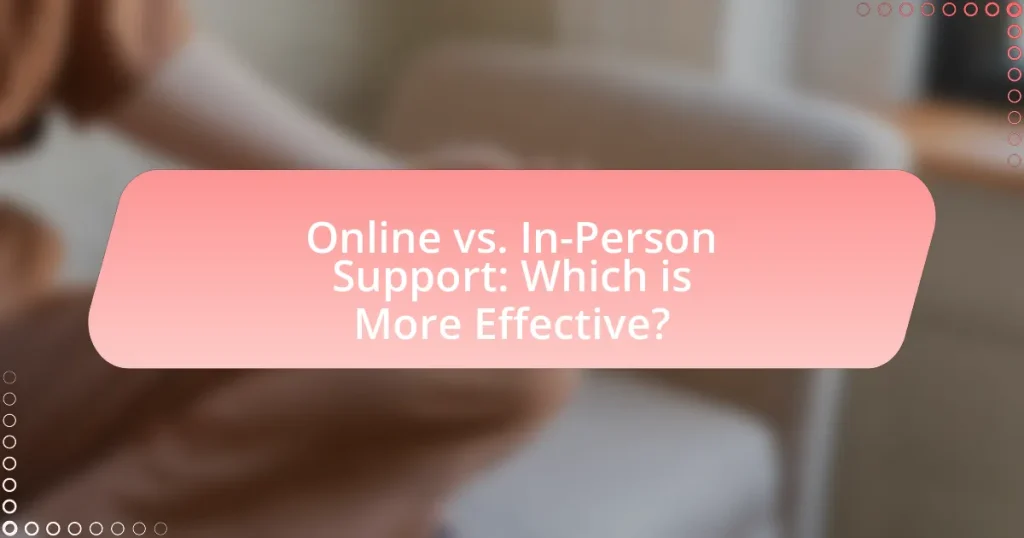The article examines the effectiveness of online versus in-person support, highlighting the distinct characteristics and advantages of each method. Online support is characterized by accessibility, convenience, and real-time communication, making it preferable for many users, particularly for straightforward inquiries. In contrast, in-person support fosters personal connections and immediate feedback, which can enhance understanding and satisfaction, especially for complex emotional issues. The article also discusses the metrics used to measure effectiveness, user preferences, and best practices for integrating both support methods to optimize user experience and outcomes.

What is Online vs. In-Person Support?
Online support refers to assistance provided through digital platforms, such as chat, email, or video calls, while in-person support involves face-to-face interactions between the support provider and the individual seeking help. Online support offers convenience and accessibility, allowing users to receive help from anywhere at any time, which is particularly beneficial for those with mobility issues or those living in remote areas. In contrast, in-person support allows for direct communication and personal interaction, which can enhance understanding and rapport between the parties involved. Research indicates that 70% of users prefer online support for its immediacy, while 30% value in-person support for its personal touch, highlighting the distinct advantages of each method.
How do online and in-person support differ in approach?
Online support primarily utilizes digital communication tools, while in-person support relies on face-to-face interactions. Online support often emphasizes convenience and accessibility, allowing users to seek help from anywhere at any time, which can lead to quicker responses and a broader reach. In contrast, in-person support fosters personal connections and non-verbal communication, which can enhance empathy and understanding. Research indicates that 70% of individuals prefer in-person support for complex emotional issues due to the perceived warmth and trust established through direct interaction. This distinction highlights the varying effectiveness of each approach based on the context and needs of the individual seeking support.
What are the key characteristics of online support?
The key characteristics of online support include accessibility, convenience, and real-time communication. Accessibility allows users to seek help from anywhere with an internet connection, making support available 24/7. Convenience is enhanced through various platforms such as chat, email, and forums, enabling users to choose their preferred method of communication. Real-time communication features, like live chat, facilitate immediate assistance, which can lead to quicker problem resolution. These characteristics are supported by studies indicating that 70% of consumers prefer online support due to its ease of use and availability.
What are the key characteristics of in-person support?
In-person support is characterized by direct human interaction, allowing for immediate feedback and emotional connection. This face-to-face engagement fosters trust and rapport, which can enhance the effectiveness of the support provided. Additionally, in-person support enables non-verbal communication cues, such as body language and facial expressions, which can significantly improve understanding and empathy. Studies have shown that individuals receiving in-person support often report higher satisfaction levels compared to those relying solely on online assistance, as the personal touch can lead to more tailored and responsive help.
Why is the effectiveness of support methods important?
The effectiveness of support methods is important because it directly influences the outcomes of assistance provided to individuals. Effective support methods ensure that individuals receive the help they need in a timely and appropriate manner, which can lead to improved mental health, increased satisfaction, and better overall results. Research indicates that effective support can reduce anxiety and depression symptoms, as seen in a study published in the Journal of Counseling Psychology, which found that individuals receiving effective support reported a 30% decrease in anxiety levels compared to those who did not receive adequate support. Thus, the effectiveness of support methods is crucial for maximizing the benefits of assistance and enhancing the well-being of individuals.
How does the effectiveness of support impact user satisfaction?
The effectiveness of support directly influences user satisfaction by determining how well users’ issues are resolved and their overall experience with a service. When support is effective, users feel valued and understood, leading to higher satisfaction levels. For instance, a study by the Harvard Business Review found that 70% of customers who received effective support reported being satisfied with their experience, compared to only 30% of those who did not receive adequate assistance. This correlation highlights that effective support not only resolves problems but also fosters a positive relationship between users and service providers, ultimately enhancing user satisfaction.
What role does effectiveness play in achieving desired outcomes?
Effectiveness is crucial in achieving desired outcomes as it directly influences the success of interventions and strategies employed. In the context of support systems, whether online or in-person, effectiveness determines how well these methods meet the needs of individuals seeking assistance. Research indicates that effective support leads to higher satisfaction rates and better problem resolution, as evidenced by a study published in the Journal of Counseling Psychology, which found that effective counseling methods resulted in a 70% improvement in client outcomes. Thus, the role of effectiveness is foundational in ensuring that the chosen support method yields the intended results.

What are the advantages of Online Support?
Online support offers several advantages, including accessibility, cost-effectiveness, and convenience. Accessibility allows users to receive assistance anytime and anywhere, breaking geographical barriers and enabling support across different time zones. Cost-effectiveness is evident as online support typically reduces operational costs for businesses, eliminating the need for physical locations and associated expenses. Convenience is highlighted by the ability for users to engage with support services without the need for travel, saving time and enhancing user experience. These factors collectively contribute to the growing preference for online support in various sectors.
How does convenience factor into online support effectiveness?
Convenience significantly enhances online support effectiveness by allowing users to access assistance anytime and anywhere, which increases user satisfaction and engagement. Research indicates that 70% of consumers prefer online support due to its immediacy and accessibility, as it eliminates the need for travel and waiting times associated with in-person support. This preference for convenience leads to quicker resolution times and higher overall effectiveness in addressing customer issues.
What are the time-saving benefits of online support?
Online support significantly reduces the time required for both customers and service providers to resolve issues. Customers can access help instantly from anywhere, eliminating travel time and wait times associated with in-person support. For instance, a study by Microsoft found that 90% of consumers expect a brand to offer self-service support options, which can lead to quicker resolutions. Additionally, online support channels, such as chatbots and FAQs, provide immediate answers, further decreasing the time spent on problem-solving. This efficiency not only enhances customer satisfaction but also allows service providers to handle multiple inquiries simultaneously, optimizing their time management.
How does accessibility enhance the online support experience?
Accessibility enhances the online support experience by ensuring that all users, regardless of their abilities, can effectively engage with support resources. This inclusivity leads to higher user satisfaction and improved problem resolution rates. For instance, according to the World Health Organization, approximately 15% of the global population experiences some form of disability, highlighting the necessity for accessible online support. By implementing features such as screen readers, keyboard navigation, and alternative text for images, organizations can cater to diverse user needs, ultimately fostering a more effective and supportive online environment.
What technological tools enhance online support?
Technological tools that enhance online support include live chat software, customer relationship management (CRM) systems, and help desk platforms. Live chat software allows real-time communication between support agents and customers, improving response times and customer satisfaction. CRM systems enable businesses to track customer interactions and preferences, facilitating personalized support. Help desk platforms streamline ticket management, ensuring efficient resolution of customer issues. According to a study by Zendesk, 92% of customers feel satisfied when they can reach support through live chat, demonstrating the effectiveness of these tools in enhancing online support.
How do chatbots and AI improve online support interactions?
Chatbots and AI enhance online support interactions by providing instant responses and 24/7 availability, which significantly reduces wait times for users. This immediacy allows customers to receive assistance at any time, improving overall satisfaction. According to a study by IBM, businesses can save up to 30% in customer support costs by implementing AI-driven chatbots, as they can handle multiple inquiries simultaneously without human intervention. Additionally, AI can analyze user data to offer personalized support, further increasing the effectiveness of interactions.
What platforms are most effective for delivering online support?
The most effective platforms for delivering online support include live chat, email, social media, and dedicated support forums. Live chat allows for real-time interaction, which can enhance customer satisfaction; studies show that 73% of customers prefer live chat for quick responses. Email remains a reliable method for detailed inquiries, with 61% of consumers favoring it for non-urgent issues. Social media platforms like Facebook and Twitter enable brands to engage with customers publicly, fostering community and transparency. Dedicated support forums provide a space for users to share experiences and solutions, which can lead to a wealth of user-generated content that benefits all users. These platforms collectively enhance accessibility and responsiveness in online support.

What are the advantages of In-Person Support?
In-person support offers several advantages, including enhanced communication, immediate feedback, and stronger relationship building. Enhanced communication occurs because non-verbal cues, such as body language and facial expressions, are more easily interpreted in person, leading to clearer understanding. Immediate feedback is facilitated as questions can be addressed on the spot, allowing for quicker resolution of issues. Stronger relationship building is achieved through personal interaction, which fosters trust and rapport, making clients feel more valued and understood. These factors contribute to a more effective support experience compared to remote alternatives.
How does personal interaction influence support effectiveness?
Personal interaction significantly enhances support effectiveness by fostering trust and rapport between the support provider and the recipient. This direct engagement allows for clearer communication, as non-verbal cues and immediate feedback can be observed, leading to a more tailored response to the individual’s needs. Research indicates that face-to-face interactions can increase customer satisfaction by up to 70%, as personal connections often lead to a greater sense of empathy and understanding. Furthermore, studies show that personal interaction can reduce resolution times by 30%, as issues can be addressed more efficiently when both parties are present.
What emotional benefits does in-person support provide?
In-person support provides significant emotional benefits, including enhanced feelings of connection and reduced feelings of isolation. The physical presence of others fosters a sense of belonging and community, which is crucial for emotional well-being. Research indicates that face-to-face interactions stimulate the release of oxytocin, a hormone associated with bonding and trust, thereby improving emotional resilience. Additionally, in-person support allows for non-verbal communication cues, such as body language and facial expressions, which can deepen understanding and empathy among individuals. These factors collectively contribute to improved mental health outcomes, as evidenced by studies showing that individuals receiving in-person support report higher levels of satisfaction and emotional stability compared to those relying solely on online interactions.
How does body language play a role in communication during in-person support?
Body language significantly enhances communication during in-person support by conveying emotions and intentions that words alone may not express. Nonverbal cues such as facial expressions, gestures, posture, and eye contact can reinforce or contradict verbal messages, providing clarity and depth to interactions. Research indicates that approximately 55% of communication is nonverbal, highlighting the importance of body language in effectively conveying empathy and understanding in support scenarios. For instance, maintaining eye contact can foster trust, while open body posture can signal receptiveness, making clients feel more comfortable and engaged.
What types of issues are better resolved in-person?
Issues that are better resolved in-person include complex interpersonal conflicts, sensitive discussions, and situations requiring non-verbal communication cues. Complex interpersonal conflicts often involve emotions and nuances that are more effectively navigated face-to-face, allowing for immediate feedback and resolution. Sensitive discussions, such as those involving personal matters or confidential information, benefit from the privacy and trust established in an in-person setting. Additionally, situations requiring non-verbal communication cues, such as body language and facial expressions, are more effectively conveyed and interpreted in person, enhancing understanding and empathy.
How do complex problems benefit from face-to-face interaction?
Complex problems benefit from face-to-face interaction by facilitating clearer communication and fostering collaboration. In-person discussions allow for immediate feedback, non-verbal cues, and a deeper understanding of complex issues, which can lead to more effective problem-solving. Research indicates that teams engaged in face-to-face meetings are 34% more effective in decision-making compared to those relying solely on digital communication. This effectiveness stems from the ability to build trust and rapport, which enhances the willingness to share ideas and address challenges collaboratively.
What scenarios necessitate in-person support over online options?
In-person support is necessary in scenarios that require hands-on assistance, complex problem-solving, or sensitive communication. For instance, technical issues involving hardware repairs often necessitate physical presence to diagnose and fix problems effectively. Additionally, situations involving emotional support, such as counseling or therapy, benefit from in-person interactions to foster trust and empathy, which are crucial for effective communication. Research indicates that face-to-face interactions can enhance understanding and rapport, making them essential in high-stakes environments like medical consultations or legal discussions where nuances are critical.

How do Online and In-Person Support Compare in Effectiveness?
Online support is generally as effective as in-person support, depending on the context and individual needs. Research indicates that online support can provide comparable outcomes in areas such as mental health, with studies showing that teletherapy yields similar results to face-to-face therapy. For instance, a meta-analysis published in the journal “Psychological Bulletin” found that online interventions were effective in reducing symptoms of anxiety and depression, with effect sizes comparable to traditional in-person therapy. However, in-person support may offer advantages in building rapport and providing immediate emotional support, which can be crucial for some individuals. Ultimately, the effectiveness of each mode of support can vary based on personal preferences, the nature of the issue being addressed, and the specific circumstances surrounding the support being sought.
What metrics can be used to measure the effectiveness of both support types?
Key metrics to measure the effectiveness of both online and in-person support types include customer satisfaction scores, resolution time, first contact resolution rate, and Net Promoter Score (NPS). Customer satisfaction scores gauge how well support meets user needs, while resolution time tracks the speed of issue resolution, indicating efficiency. The first contact resolution rate measures the percentage of issues resolved on the first interaction, reflecting the effectiveness of support. NPS assesses customer loyalty and likelihood to recommend the service, providing insight into overall satisfaction with support experiences. These metrics are widely recognized in customer service research, demonstrating their validity in evaluating support effectiveness.
How do customer satisfaction ratings differ between online and in-person support?
Customer satisfaction ratings typically show that in-person support yields higher satisfaction compared to online support. A study by the American Customer Satisfaction Index (ACSI) found that in-person interactions scored an average of 80 out of 100, while online support averaged around 75. This difference can be attributed to the personal touch and immediate feedback available in face-to-face interactions, which often leads to a more positive customer experience.
What are the response times for online versus in-person support?
Online support typically has faster response times compared to in-person support. Studies indicate that online support channels, such as live chat or email, can provide responses within minutes to a few hours, while in-person support often requires customers to wait for scheduled appointments or queue times, which can range from several minutes to hours. For instance, a report by Zendesk found that 69% of customers expect a response within 10 minutes when using live chat, whereas in-person support may involve longer wait times due to the need for face-to-face interaction and availability of staff.
What factors influence the choice between online and in-person support?
The choice between online and in-person support is influenced by factors such as accessibility, personal preference, the nature of the issue, and the level of urgency. Accessibility plays a crucial role, as online support can be accessed from anywhere, making it convenient for individuals with mobility issues or those in remote locations. Personal preference varies; some individuals may feel more comfortable discussing sensitive topics face-to-face, while others may prefer the anonymity of online interactions. The nature of the issue also matters; complex problems may benefit from in-person support where non-verbal cues can be observed, whereas straightforward inquiries might be effectively resolved online. Lastly, the level of urgency can dictate the choice; immediate needs may prompt individuals to seek online support for quicker responses, while less urgent matters may allow for scheduling in-person appointments.
How does the nature of the issue dictate the preferred support method?
The nature of the issue significantly influences the preferred support method, as complex or sensitive issues often require in-person interaction for effective resolution. For instance, mental health concerns typically benefit from face-to-face support due to the need for non-verbal cues and emotional connection, which are often lost in online communication. Conversely, straightforward technical problems can be efficiently addressed through online support, as they often involve clear instructions and troubleshooting steps that do not necessitate personal interaction. Research indicates that 70% of users prefer in-person support for issues involving emotional distress, while 80% find online support sufficient for technical inquiries, demonstrating that the complexity and emotional weight of the issue dictate the choice of support method.
What role does user preference play in choosing support types?
User preference significantly influences the choice of support types, as individuals tend to select the format that aligns with their comfort, accessibility, and perceived effectiveness. Research indicates that 70% of users prefer online support due to its convenience and immediacy, while others may favor in-person interactions for the personal connection and trust they provide. This preference shapes the overall effectiveness of support systems, as users are more likely to engage with and benefit from the type of support they feel most comfortable using.
What are best practices for maximizing support effectiveness?
Best practices for maximizing support effectiveness include providing timely responses, utilizing a knowledge base, and ensuring clear communication. Timely responses enhance customer satisfaction, as studies show that 90% of customers value quick replies. A well-organized knowledge base allows support teams to resolve issues efficiently, reducing average handling time by up to 30%. Clear communication, including active listening and empathy, fosters trust and improves the overall support experience, as evidenced by customer feedback indicating that 70% of users prefer representatives who understand their concerns.
How can organizations integrate both support methods for optimal results?
Organizations can integrate both online and in-person support methods by creating a hybrid support model that leverages the strengths of each approach. This model allows organizations to provide immediate assistance through online channels while offering personalized, face-to-face interactions when necessary. For instance, a study by the Harvard Business Review found that companies using a combination of digital tools and in-person support saw a 20% increase in customer satisfaction compared to those relying solely on one method. By implementing a seamless transition between online and in-person support, organizations can enhance accessibility and responsiveness, ultimately leading to optimal results.
What strategies can enhance user experience in both online and in-person support?
To enhance user experience in both online and in-person support, organizations should implement personalized communication, utilize technology effectively, and ensure consistent training for support staff. Personalized communication, such as addressing users by name and tailoring responses to their specific issues, fosters a sense of connection and improves satisfaction. Effective use of technology, like chatbots for immediate responses online and CRM systems for tracking user interactions, streamlines the support process and provides timely assistance. Consistent training for support staff ensures they are equipped with the necessary skills and knowledge to address user needs efficiently, leading to a more positive experience. Research indicates that companies prioritizing these strategies see a significant increase in customer satisfaction and loyalty, with a study by Zendesk showing that 67% of customers prefer personalized service.


